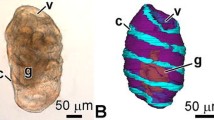Summary
Metachromatically-staining substances have been found in the secretion of the stomodeum and esophagus of the echinopluteus (Psammechanus miliaris). This secretion seemed to derive from specialized cells in the wall of the foregut. Ultrastructural examination revealed that these cells are rich in large cisternae containing an electron-translucent material. They are also rich in ribosomes and possess large Golgi complexes. The number of secretory cells increases with age. It is tempting to speculate that the function of these cells is analogous to that of the glandular cells of the endostyle in some chordate phyla.
Similar content being viewed by others
References
Berridge, M. J.: The mode of action of 5-hydroxytryptamine. J. Exp. Biol.56, 311–321 (1972)
Berridge, M. J., Patel, N. G.: Insect salivary glands: Stimulation of fluid secretion by 5-hydroxytryptamine and adenosine-3′,5′-monophosphate. Science162, 462–463 (1968)
Fontaine, A. R.: Secretion of a highly sulphated acid mucopolysaccharide by the brittle-starOphiocomina nigra. Nature176, 606–607 (1955)
Fontaine, A. R.: The integumentary mucous secretions of the ophiuroidOphiocomina nigra. J. mar. biol. Ass. U.K.44, 145–162 (1964)
Gustafson, T., Lundgren, B., Treufeldt, R.: Serotonin and contractile activity in the echinopluteus. A study of the cellular basis of larval behaviour. Exp. Cell Res.72, 115–139 (1972a)
Gustafson, T., Ryberg, E., Treufeldt, R.: Acetylcholine and contractile activity in the echinopluteus. A study of the cellular basis of larval behaviour. Acta Embr. Exp. 199–223 (1972b)
Hunt, S.: Polysaccharide sulphates. In Polysaccharide-protein complexes in invertebrates, pp. 91–100. London-New York: Academic Press 1970
Immers, J.: Changes in acid mucopolysaccharides attending the fertilization and development of the sea urchin. Arkiv för zoologi9, 367–375 (1956)
Immers, J.: Comparative study of the localization of incorporated14C-labeled amino acids and35SO4 in the sea urchin ovary, egg and embryo. Exp. Cell Res.24, 356–378 (1961)
Immers, J., Markman, B., Runnström, J.: Nuclear changes in the course of development of the sea urchin studied by means of Hale staining. Exp. Cell Res.47, 425–442 (1967)
Immers, J., Lundgren, B.: Aspects of differentiation and function of cilia and adjacent structures of the sea urchin larva. Acta Embr. Exp. 177–197 (1972)
Luft, J. H.: Improvements in epoxy resin embedding methods. J. biophys. biochem. Cytol.9, 409–414 (1961)
Lundgren, B.: A quantitative estimation of the association of mitochondria to septate desmosomes in the sea urchin larva. Exp. Cell Res.85, 429–436 (1974a)
Lundgren, B.: Aspects of sea urchin development from blastula to pluteus, with special reference to contractile elements and cell contacts. Thesis (offset print). The Wenner-Gren Institute for Experimental Biology, University of Stockholm, Stockholm, Sweden (1974b)
MacBride, E. W.: Textbook of Embryology, Vol. I, pp. 456–567 (W. Heape, ed.). London: MacMillan & Co Ltd. 1914
Olsson, R.: Endostyles and endostylar secretions: A comparative histochemical study. Acta Zool.44, 299–328 (1963)
Olsson, R.: The cytology of the endostyle ofOikopleura dioica. Ann. New York Acad. Sci.118, 1038–1051 (1965)
Pearse Everson, A. G.: Histochemistry theoretical and applied. Third edition. Vol. I. London: J. & A. Churchill Ltd. 1968
Reynolds, E. S.: The use of lead citrate at high pH as an electron opaque stain in electron microscopy. J. Cell Biol.17, 208–212 (1963)
Ryberg, E.: The localization of cholinesterases and non-specific esterases in the echinopluteus. Zoologica Scripta2, 163–170 (1973)
Ryberg, E.: The localization of biogenic amines in the echinopluteus. Acta Zool.55, 179–189 (1974)
Author information
Authors and Affiliations
Rights and permissions
About this article
Cite this article
Ryberg, E., Lundgren, B. Secretory cells in the foregut of the echinopluteus. Wilhelm Roux' Archiv 177, 255–262 (1975). https://doi.org/10.1007/BF00848177
Received:
Issue Date:
DOI: https://doi.org/10.1007/BF00848177




